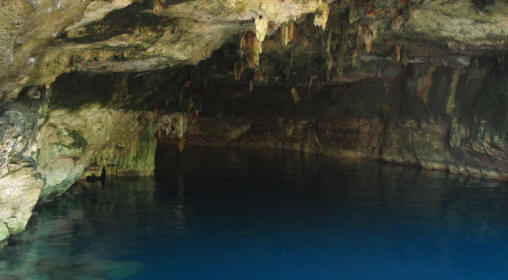Where can you find me?
Deriving from the surface
dwelling Mexican tetra, also known as the Mexican Blindfish (Astyanax
mexicanus), the Astyanax jordani is a
freshwater, cave dwelling fish. Although the Mexican Blindfish
was only relatively recently discovered in the 1930's, it is
believed that A.mexicanus migrated into Mexican caves
about two to three million years ago, and the evolution of the
of the A. jordani followed soon thereafter
(Kemsley,2014). There are over 25 cave species that have
been found to originate in the lower Rio Grande river, but
current known cave populations are found to inhabit many caves
in rivers and lakes of
northeastern Mexico.
The A.jordani are considered benthopelagic. This means that they feed and spend their time near the bottom, as well as in mid-waters or near the surface and so they really aren't all that picky with their abode. Although these fish are accustomed to any area of their deep dark cave, they find themselves closer to the bottom of the cave when feeding. Because they come from a subtropical climate, the A.jordani prefers waters with pH levels between 6.0-7.8, and water temperatures ranging from 68-77°F (Sharpe, nd). Just like this species of fish, there are many other organisms that love the deep dark abyss such as the Squilla mantis. Through many different converging factors, this creature has found its home in deep water as well. Check it out HERE.
Because of the unique cave environment that these fish find themselves living, they share their environment with some special critters. All of these specimens are considered trogoblites. Trogoblites are creatures that have adapted to live in the dark confines the cave world has to offer (Geology.com). All of these animals have keen senses of hearing, touch and smell. Some common trogoblites include millipedes, salamanders, spiders, fish and beetles. Learn about the Blind Cavefish's interactions with some of these species here!
 This
fish also can be found in many household and commercial fish tanks around the world. The
Blind Cavefish is one of the most popular novel fish available to
the community-tanking world. With the qualities of being active
swimmers,
being fairly easy to take care of, and being relatively peaceful
fish, they make a great addition to any freshwater tank. Larger sized
tanks are preferred when it comes to this highly active swimmer.
Although in the wild they are found in dark caves, lighting is not a
major concern when it comes to health of the fish in the tank
environment. Although, it has been reported that they do prefer
non-direct light, and will swim to areas of the tank that have less
light (Sharpe nd).
This
fish also can be found in many household and commercial fish tanks around the world. The
Blind Cavefish is one of the most popular novel fish available to
the community-tanking world. With the qualities of being active
swimmers,
being fairly easy to take care of, and being relatively peaceful
fish, they make a great addition to any freshwater tank. Larger sized
tanks are preferred when it comes to this highly active swimmer.
Although in the wild they are found in dark caves, lighting is not a
major concern when it comes to health of the fish in the tank
environment. Although, it has been reported that they do prefer
non-direct light, and will swim to areas of the tank that have less
light (Sharpe nd).
Go
back home! Now that you know about this critters abode, take a look at its
unique adaptations HERE!!
Want to see other organisms created by UWL students:
Check out
MultipleOrganisms.net!